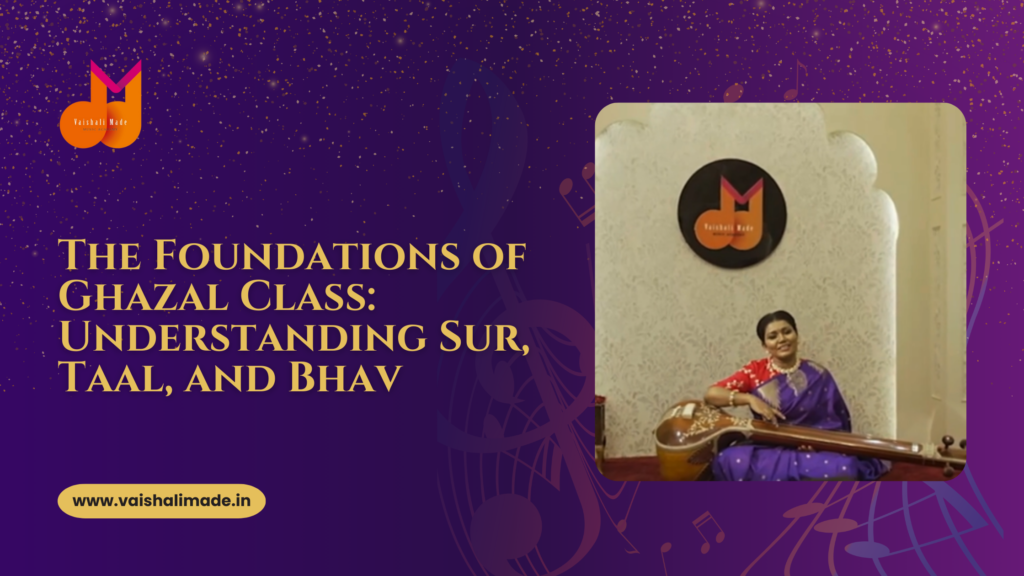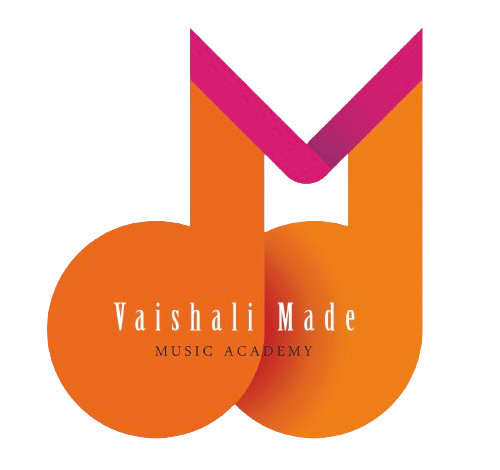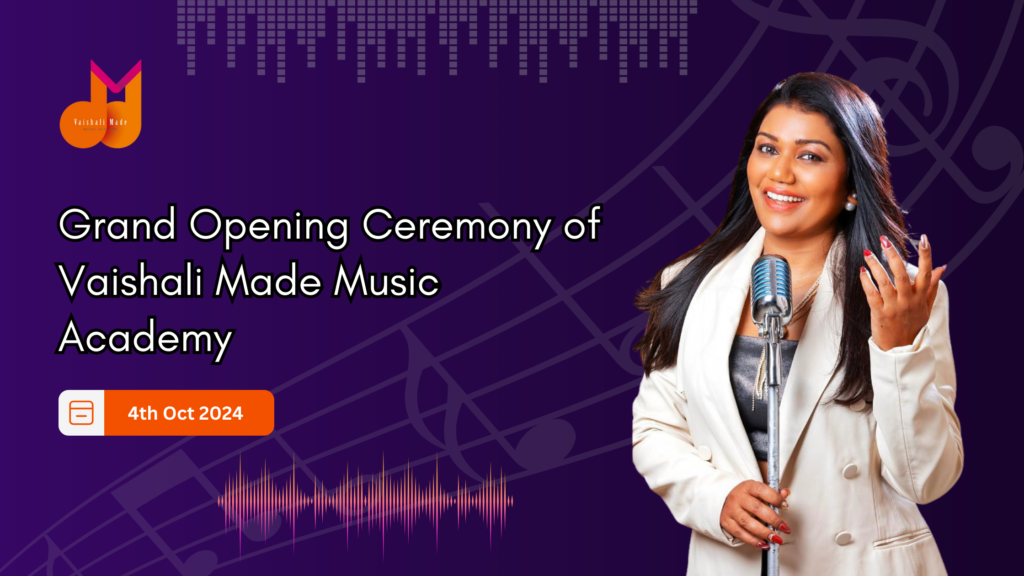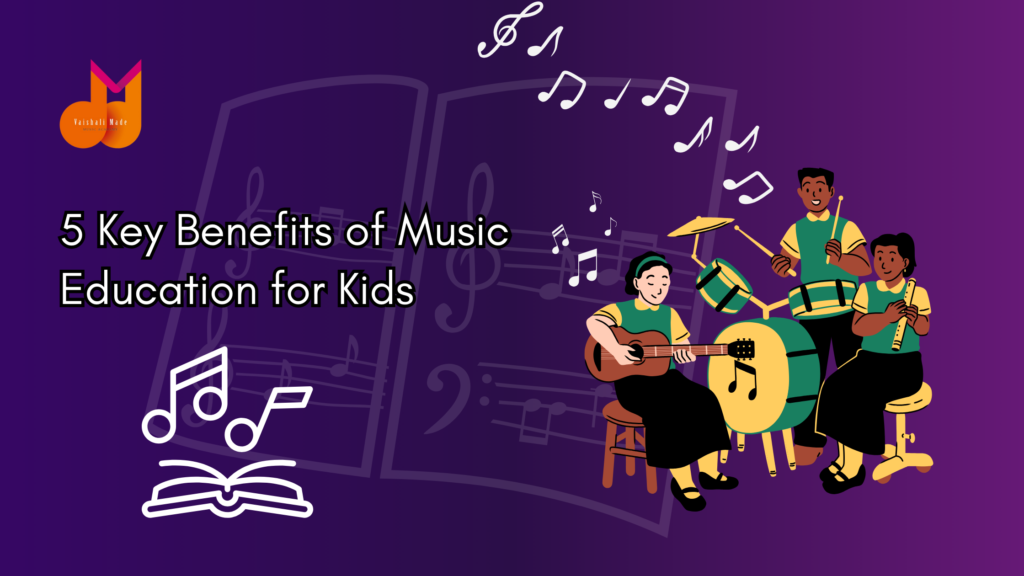
Ghazal is one of the most soulful and expressive forms of music, blending poetry and melody to create an immersive emotional experience. Unlike mainstream music, where rhythm and energy often take center stage, Ghazal is all about storytelling, deep emotions, and intricate vocal techniques.
For a singer, learning Ghazal is not just about hitting the right notes; it is about interpreting the poetry, controlling the voice, and maintaining rhythm while expressing intense emotions.
At Vaishali Made Music Academy, we provide structured Ghazal training that focuses on Sur (melody), Taal (rhythm), and Bhav (emotion)—the three essential elements that define a great Ghazal singer.
This blog will explore the key techniques, structured learning approach, and how students experience a transformational journey after joining Vaishali Made Music Academy.
1. Understanding Sur (Melody) in Ghazal Singing
What is Sur?
Sur refers to the musical notes that form the basis of any melody. In Indian classical music, the seven basic notes (Sa, Re, Ga, Ma, Pa, Dha, Ni) are arranged in different sequences to create various ragas—the foundation of Ghazal melodies.
Ghazals are often composed in soft, melodious ragas that complement the lyrical depth of the poetry.
Why is Sur Important in Ghazal?
Sur is crucial in Ghazal because:
- It ensures the melody complements the emotions of the lyrics.
- It helps the singer maintain vocal stability and tunefulness.
- A well-executed Sur enhances the poetic storytelling of a Ghazal.
Techniques Used at Vaishali Made Music Academy to Develop Sur
At Vaishali Made Music Academy, we follow a structured approach to help students master Sur:
- Swara Training: Teaching students how to identify and sing different notes.
- Aakar Sadhana: Practicing long notes using ‘Aa’ to strengthen vocal clarity.
- Voice Modulation: Learning how to control tone and pitch for expressive singing.
- Listening and Imitation: Studying legendary Ghazal singers to understand different melodic styles.
- Breath Control Exercises: Ensuring sustained and stable singing for long phrases.
Ragas Commonly Used in Ghazal Singing
Ghazals often follow specific ragas that evoke different emotions. Some common ragas in Ghazal include:
- Raga Yaman: Expressive and soothing, perfect for romantic Ghazals.
- Raga Bhairavi: Deep and introspective, used for melancholic Ghazals.
- Raga Pahadi: Simple yet expressive, often found in folk-style Ghazals.
- Raga Darbari Kanada: Evokes depth and seriousness, suited for profound Ghazals.
Through regular raga-based practice, students at Vaishali Made Music Academy develop their vocal precision and emotional delivery.
2. The Role of Taal (Rhythm) in Ghazal Singing
What is Taal?
Taal refers to the rhythmic cycle that structures a song’s tempo and flow. In Indian music, rhythm plays an essential role in maintaining timing, pace, and mood.
Common Taals Used in Ghazal
Unlike classical and Bollywood songs, Ghazals follow relatively simple rhythmic structures. Some common taals in Ghazal singing include:
- Keherwa (8 beats): The most commonly used taal, offering a steady and balanced rhythm.
- Dadra (6 beats): A slow-paced rhythm that enhances emotional expression.
- Rupak (7 beats): A unique rhythmic cycle that adds character to semi-classical Ghazals.
Techniques Used at Vaishali Made Music Academy to Teach Taal
At Vaishali Made Music Academy, we ensure students develop a natural sense of rhythm through:
- Clapping Exercises: Helping students internalize rhythm patterns.
- Practice with Tabla or Metronome: Ensuring precision in beat synchronization.
- Slow and Fast Tempo Training: Teaching adaptability for different Ghazal styles.
- Understanding Laya (Speed Variations): Helping students transition between slow and fast tempos.
By mastering Taal, students achieve fluidity and grace in their Ghazal performances.
3. The Importance of Bhav (Emotion) in Ghazal Singing
What is Bhav?
Bhav, or emotional expression, is the heart of Ghazal singing. Unlike other music forms where technical accuracy is prioritized, Ghazal requires a singer to convey deep emotions through their voice.
Why is Bhav Crucial in Ghazal Singing?
Since Ghazals focus on themes like love, longing, separation, and devotion, a singer must interpret and express these emotions convincingly. Without Bhav, even a technically perfect Ghazal can feel lifeless.
Techniques Used at Vaishali Made Music Academy to Enhance Bhav
- Understanding the Poetry: Analyzing lyrics to grasp their deeper meaning.
- Voice Modulation: Adjusting pitch, tone, and intensity based on emotions.
- Slow Singing Practice: Singing phrases slowly to emphasize emotional depth.
- Stage Performance Coaching: Helping students gain confidence in expressing emotions while performing.
Through these techniques, students learn to touch hearts with their singing rather than just reciting lyrics.
4. Structure of Ghazal Classes at Vaishali Made Music Academy
At Vaishali Made Music Academy, we provide a structured, progressive approach to Ghazal learning. Our courses cater to beginners, intermediate learners, and advanced singers.
Beginner’s Course
- Introduction to Sur, Taal, and Bhav.
- Learning basic ragas and rhythmic cycles.
- Understanding poetry and lyrical interpretation.
Intermediate Course
- Raga-based Ghazal training.
- Developing voice modulation and breath control.
- Performing solo Ghazals with instrumental accompaniment.
Advanced Course
- Learning complex Ghazal compositions.
- Stage performance training.
- Recording professional-quality Ghazals.
Each student receives personalized guidance, ensuring steady progress and skill refinement.
5. The Transformational Journey of a Ghazal Singer at Vaishali Made Music Academy
Joining Vaishali Made Music Academy is a transformative experience for any aspiring Ghazal singer. Our students undergo a complete musical and emotional evolution.
Before Joining the Academy:
- Difficulty in maintaining Sur and Taal.
- Lack of confidence in expressing emotions.
- Struggles with breath control and vocal stability.
After Joining the Academy:
- Mastery of Sur, Taal, and Bhav through structured training.
- Enhanced voice modulation for expressive singing.
- Increased confidence in stage performances and recordings.
- Ability to interpret and express complex poetry through music.
Many of our students have gone on to:
- Perform at live concerts and Mehfils.
- Record and release their own Ghazals.
- Participate in prestigious musical competitions.
By providing a holistic, immersive learning experience, Vaishali Made Music Academy helps students unlock their full artistic potential.
Conclusion
Ghazal singing is an art of melody, rhythm, and emotion. Learning Ghazal requires dedication, discipline, and structured training from experienced mentors.
At Vaishali Made Music Academy, we nurture raw talent into refined artistry, helping students evolve into soulful, expressive Ghazal singers.
If you are passionate about Ghazal and want to explore its timeless beauty, join Vaishali Made Music Academy today!
👉 Enroll now and embark on your journey into the mesmerizing world of Ghazals!


